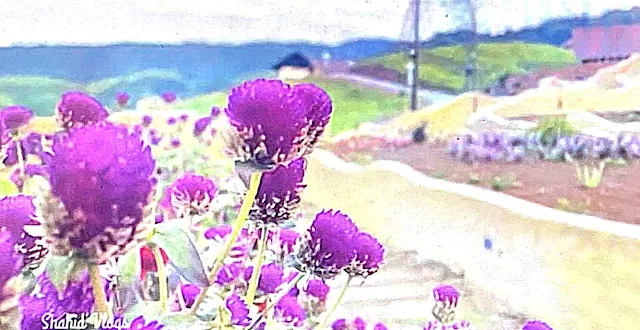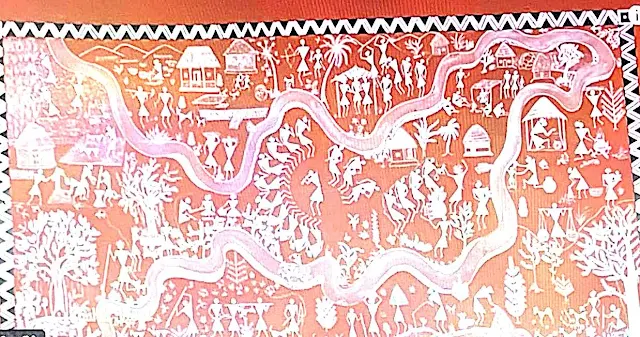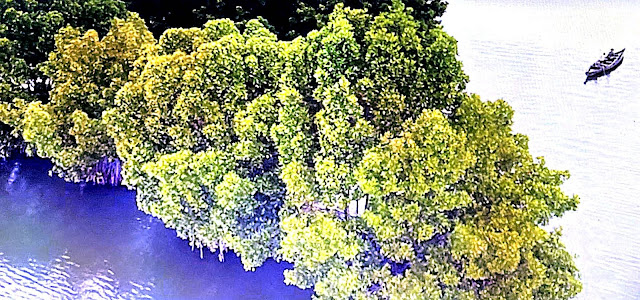En Ooru Tribal Heritage Village at Pookode, Wayanad.
En Ooru is a mesmerizing beauty and showcases the
vibrant culture and tradition of tribal communities of the state. We can see a
cluster of traditional tribal huts roofed with hay. The location is against the
backdrop of towering hills in the region. The center gives us a golden
opportunity to learn about the heritage and lifestyle of tribespeople. Spread
over 25 acres on a hillock, the site is captivating.
Features:
- There are options to enhance the livelihood of tribal communities.
- The village hosts cafeterias that serve ethnic dishes
- A tribal market.
- Stalls selling souvenirs, spices, and handicrafts of tribal artisans
- A warehouse for collecting handicrafts
- A felicitation center
- And an open-air theatre with a seating capacity of 300 people.
- The center stages tribal art forms.
- Tribal food fest, and art fest.
- En Ooru, the first of this kind in Kerala, introduced indigenous architecture coupled with tribal customs and traditions.
This project enhances the tribal communities’
livelihood options and provides direct and indirect job opportunities. Tribal
huts covered with hay, around 2 acres of land, and 16 stalls that sell
souvenirs, handicrafts of tribal artisans, etc., are the main attractions of
this place.
En Ooru Tribal Heritage Village is an initiative of
the Government of Kerala. I am hopeful it will grow into an exclusive and
permanent platform for the tribes in Kerala.
At the end of Thamarassery Ghat road at Lakkidy, an inviting wind engulfs us from Wayanad, the hill district with its varied ethnic diversities and unique culture.
- Wayanad, the green paradise spread across 2131 sq. km, is a home for many tribal groups. It is a real feast for us.
- It is a picturesque plateau (height between 700 meters and 2100 meters above the mean sea level) nested among the mountains of the Western Ghats.
En Ooru’ (my village) is 4 km past Lakkidy through
NH 766, near
the Veterinary University.
Entrance
Climate:
The average annual lowest temperature measured in Wayanad is 18.5°C (65.3°F) in January.
The coldest time of year in Wayanad is also in January.
The wettest months in Wayanad are June and July.
The warmest time of year in Wayanad is around February.
The temperatures usually rise to 33.5°C (92.3°F).
Here is a quick climatic information:
Coldest Month: July (27 °C average)
Wettest Month: June (501.2 mm average)
Windiest Month: March (5 km/h average)
Annual precipitation: 2006.8 mm (per year)
Tribal domain:
It showcases the ethnic culture of all communities
(Kuruma, Kurichya, Adiya, Oorali, Kattunaikka, and Oorali kuruma) of Wayanad
under one umbrella.
We can experience:
- the culture, traditions, art, medicinal practices, music, and architecture of the tribes.
- There are daily music and dance performances at the huts by the tribal people. The performance by an ethnic percussion instrument (thudi) with the rhythmic movement is another attraction.
- Unique art forms presented by artists from various settlements are there every day.
An open-air theatre with a seating capacity for 300 people, a felicitation center, and a warehouse for storage purposes are other best parts of the center. In addition to that, there are two cafeterias and a Kudumbasree unit offering ethnic cuisines.
Tribal art forms:
Isolated existence and preserving the lives and
customs are the way of life of tribals of Kerala. They are almost immune to
urbanization.
- They keep a rhythm with the pulse of nature. Their art forms are fascinating, and their presentation is simple.
- They formulated all the art forms, identifying reasons for expressions from their traditional life.
Art forms often convey:
- Their candid feelings from their experiences in life.
- To emphasize the values, traditions, and lifestyle followed by a tribe.
- To show respect to Mother Nature.
The artistic expressions reflect their distinct,
secluded, and ancient social structure.
Tribal art forms still survive in the hamlets of
Kerala's forested hilly tracts. Each community has its distinct dance
tradition. Some of the musical instruments used by the tribal people are
unique, with drums of varying sizes and tones.
Let me introduce some of the tribal art forms of
Kerala.
Gadhika or Gaddika:
Performed by the Adiyaan community in Wayanad, the origin of Gadhika is attributed to the arrival of Goddess Devi - Mariyamman from Mysore in the nearby state of Karnataka- to Wayanad in Kerala.
Gaddika is a ritual art form performed to cure disease and
ward off miseries and evil eyes. There are two variations. Nattu Gadhika is a
public performance, and Pooja Gadhika is a ritual.
Adiyas believe that sickness and suffering are due
to the wrath of God. Adiyas believe in witchcraft, and there are many customs
and rituals practiced among them. [1] The aim is to gladden the Goddess.
The whole presentation of this ritual art form is
like a dance and drama form.
- A team of musicians plays wind instruments and percussions.
- Performers dance around a lighted lamp.
- The lead performer interacts with the musicians during the dance, argues with them, tries to find a resolution, and finally does his best to appease Goddess Devi.
Midhuva Dance:
This dance form is to mark the occasion of nuptial
ceremonies. The Midhuva ritual is one such expression through dance and music
performed as part of it.
- Performed by members of the Nayikkan tribe, the dance comprises men and women.
- They dance with simple steps, clapping hands, maintaining a circular pattern, and sideways swaying movements.
Kambara nritham:
The Kambara nritham or Kambara dance is a folk dance performed by the Adiyan tribe of Wayanad, a northern district of Kerala. [2]
- This dance has a connection to paddy cultivation.
- In this art form, men sing folk songs and play wind and percussion instruments, while women dance near the paddies where saplings are collected.[2]
Paintings:
Idital or Edital is a form of Indian painting. A kind of Saura painting was invented and practiced by the Sora people. The artisans paint Idital as a symbol of devotion to the tribal deity Idital or Edital.
- Each piece of the ideal painting contains symbols and signs and conveys a distinct meaning.
- Every stroke of paint on the canvas represents a connection to nature and the world around us.
- The artists behind these masterpieces have an innate understanding of their surroundings, using their creativity to bring a painting of their thoughts and beliefs.
In this enchanting corner of Wayanad, the tribal paintings at En Ooru serve as a bridge between ancient traditions and modern interpretations.
- They remind us that art has no boundaries or limitations, transcending language barriers and cultural differences.
- En Ooru persists in preserving their heritage amidst changing times.
- They stand as a testament to the power of art to transcend time and connect us all through its universal language.
Whether you are an art enthusiast or simply curious
about different cultures, exploring the tribal paintings at En Ooru will
undoubtedly leave you captivated by their beauty and significance.
Basic geometric shapes used in paintings:
Circles, triangles, and squares are symbolic of
different elements of nature. The circle represents the sun and the moon, and
the triangle depicts mountains and conical trees. In contrast, the square
indicates a sacred enclosure or a piece of land.
- The central motif in the ritual painting is portraying scenes like hunting, fishing, farming, and trees and animals.
- Two inverse triangles joined at their tips represent people and animals: the upper triangle depicts the torso, and the lower triangle is the pelvis.
- Their equilibrium symbolizes the balance of the universe, and this representation also has the practical and amusing advantage of animating the bodies.
Theme, color, and style
- The iconic line drawings of Idital are simple geometrical forms.
- Humans, horses, elephants, the sun, the moon, and the Tree of Life are recurring motifs in the ikons. [2]
- The preparation of the backgrounds of the paintings using ochre. The color may be red or yellow.
- They paint over it using brushes created from tender bamboo shoots.
- Natural dyes and chromes derived from ground white stone, hued earth, and vermilion and mixtures of tamarind seed, flower, and leaf extracts, etc. [3][4][5]
- Ochre, a natural pigment derived from clay, has played a significant role in art throughout history.
- Its warm and earthy tones provided a vibrant backdrop for their artistic expressions.
- What makes ochre fascinating is its versatility.
- It can range from pale yellows to deep reds, offering artists a spectrum of colors.
- This range allows for diverse landscapes, from sun-drenched deserts to lush forests.
Beyond its aesthetic appeal, ochre also holds
cultural significance. In many indigenous cultures, the use of ochre ranges
from a pigment to a symbol of identity and spirituality. The preparation
process of ochre becomes part of the artistic journey, connecting artists with
their ancestral roots.
- In contemporary art, artists continue to explore the potential of ochre in creating evocative backgrounds.
- Its timeless charm adds depth and texture to modern masterpieces while paying homage to ancient traditions.
- In conclusion, ochre usage in painting backgrounds is not merely about color but about connecting with our past and embracing our artistic heritage.
- Its ability to evoke emotions and tell stories through its hues makes it an indispensable tool for artists seeking to create captivating works that transcend time and culture.
Tribal market:
A well-organized place is there, inside the center, that sets up a tribal market.
- You can pick Millets, Wild Honey, and other Forest products procured by tribal people. Kambalam, Ambum Villum (Bow and Arrow), Tribal Artefacts, and other products get a place in the market.
- The tribal market supports the community and the Tribal Economy.
- Bamboo, cane products, indigenous medicines, medicinal plants, and food are available there.
- To catch the eyes of the visitors, artists perform their craft skills live at their stalls.
- It is the finest platform to learn about tribals and interact with them.
Mist Associated with Drizzle at En Ooru: A Mystical Phenomenon
En Ooru, a quaint little town nestled amidst lush
green hills, is known for its enchanting beauty and serene atmosphere.
However, one thing that has puzzled both locals and
visitors alike - is the mist associated with drizzle.
- When drizzle descends upon En Ooru, it accompanies a delicate mist that seems to dance among the trees and meadows.
- This mist creates an ethereal ambiance, casting a veil of mystery over the town.
- It is as if nature is weaving a magical tapestry for all to behold.
- The mist adds an extra layer of intrigue to the already captivating landscape of En Ooru.
- When the mist envelopes the surroundings, it creates an otherworldly experience for those fortunate enough to witness it.
- The air becomes cool and refreshing as if touched by unseen hands.
The mist associated with the drizzle at En Ooru
adds an element of magic and wonder to this already enchanting town.
So, when you find yourself in En Ooru during a
drizzle, embrace the mist too.
- Allow yourself to transport into a world where reality blends seamlessly with fantasy.
- Let tantalize your senses with this extraordinary phenomenon and let your imagination run wild amidst nature's masterpiece.
Hey roofed hut
The panoramic view of the beauty of Wayanad is a feast to our eyes.
- Its surrounding grassland, hillocks, peaks of the mountain kissing dancing clouds, and mountain mist flowing down the valley are eye-catching.
- The cool climate, misty peaks, and green forests are the distinguished features of Wayanad.
- The whole area is green with hills and valleys and natural life.
Stunning simplicity:
- The pristine architectural design of the tribal village is beautiful.
- Huts with bamboo ceilings and hey-roofs are simple and eye-catching.
- Laterite stones for outdoor tiling are beautiful.
- All this together makes En Ooru a village beauty showcasing stunning simplicity.
1.
"Gaddika - a tribal art form of Kerala". keralaculture.org. Department of Culture,
Government of Kerala. 22 April 2019. Archived from the original on 2019-04-22.
2.
Wikipedia
3 ^ "Centre develops Saura tribal paintings of Raygada"IDITAL
TRIBE–SOURA"
4^ "Timeless
images" –
Odisha"
5^ "TRIBES ODISHA - SAORA IDTAL
PAINTINGS"






















Comments
Post a Comment